BACKGROUND:
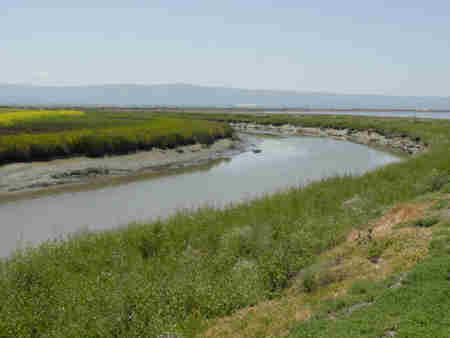 The
life of the San Francisco Bay is dominated by little
critters. None of the organisms of the San Francisco
Bay mud life are exceptionally beautiful nor unique, but all are part of a
food web. The picture to the left was taken at Mud Slough which flows into
the southern part of the San Francisco Bay in the City of
Fremont. The
life of the San Francisco Bay is dominated by little
critters. None of the organisms of the San Francisco
Bay mud life are exceptionally beautiful nor unique, but all are part of a
food web. The picture to the left was taken at Mud Slough which flows into
the southern part of the San Francisco Bay in the City of
Fremont.
In an ecosystem, organisms play different roles in the food
web. There are primary producers, primary consumers, and then different
levels of secondary consumers.
However before you determine the position of an
organisms in a food web you need to identify the organisms
first. In this lab, the students
will first take a look at the different organisms of the mud (from the San Francisco Bay) and then they will analyze their positions
in the food chain.
This lab can be customized to either a lake, pond,
river, or marsh in your area. However, bays or along a coastline are preferable.
Look for a place where the currents may concentrate shells. In lakes
or ponds you may look at where some birds eat and find left over
shells.
PROCEDURE:
- Discuss with students how they can determine
the role that an organism plays in an ecosystem. Review that the plants are primary producers
(produce their own food through photosynthesis) and the smaller
animals like snail are primary consumers (first eat primary
producers). A secondary consumer would be an animal that
eats primary consumers. The food chain can have several
layers, and several levels can be eaten by more than one
organism.
- Read "Murder in the Mud" to students. The story
is just a fun way to point out which organisms eat one another.
The carnivore, or Hannibal Radula, contains a tooth like structure
called a radula that can actually bore through the shell of another
organism that will be its next dinner.
- Biologists classify organisms because it is easy to talk with
other biologists if the name is standardized. When students select
the different groups, have them name the organism as a class. The
scientific name is fine, but naming their own organism can even be fun.
Try to get them to name the organism to reflect what that shell looks like.
Have them select two parts of the name (Genus + species). You can use the analog that
people's names help identify them, so genus + species helps scientists
identify the different organisms.
Have the students draw and describe the samples of sea life by
name and key characteristics. The students need not name the sea
life by their scientific names. They can devise or invent names for
the organisms. However, if you want them to use the correct scientific
names which is described below.
In your kit you have 5 to 7 different types of organisms on
the species level. You may have one or two organisms that are not
in the following description. These mollusks represent only a
fraction of the population. These shells were collected under the
Dumbarton Bridge (between the cities of Fremont and Menlo Park,
California). The proportion that is in your container reflects the
ratio in which they were found, which changes seasonally. You can
discuss with your students why some are more abundant than others.
This has to do with which organisms are more abundant but also how they
were transported after they died.
Using these specimens you can devise several activities with
your students, not only the prescribed lab. Mix all the shells together
and have them separate the different groups. Depending on the verbal
and written skills of your students, you may want them to start writing
a description of the little organisms. Direct their attention to
size, shape, color, and ornamentation on the shell. You can also
have them draw the different types, as drawing tends to really develop
their observational skills.
SAN FRANCISCO BAY MOLLUSK FAUNA
On the information below, the position of each
organism in the food chain is outlined, and a food web can be created.
BIVALVES
Gemma gemma -  Shell
is no longer than high, slightly triangular; general color white with purple
tinge, shell very thin, hinge and teeth very reduced. Introduced to
the San Francisco Bay from the east coast. This bivalve is a filter
feeder, meaning that it takes in water and "filters" the algae
from it to digest. It is considered a primary consumer. Shell
is no longer than high, slightly triangular; general color white with purple
tinge, shell very thin, hinge and teeth very reduced. Introduced to
the San Francisco Bay from the east coast. This bivalve is a filter
feeder, meaning that it takes in water and "filters" the algae
from it to digest. It is considered a primary consumer.
|
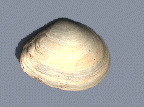 Macoma nasuta - Also called the bent-nosed
macoma. Lives
in shallow water with muddy bottoms. Some are 3-4 cm long, color
grayish white. Anterior end broadly rounded; posterior end bluntly
pointed, partially truncated and noticeably bent to one side and is a filter
feed like G. gemma. Macoma nasuta - Also called the bent-nosed
macoma. Lives
in shallow water with muddy bottoms. Some are 3-4 cm long, color
grayish white. Anterior end broadly rounded; posterior end bluntly
pointed, partially truncated and noticeably bent to one side and is a filter
feed like G. gemma.
|
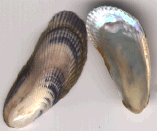 Iscadium demissum
- Also known as the ribbed horse mussel has fine ribbed
lines running lengthwise. This purple mussel grows to 3.5 inches. Pearly luster inside of shell. Iscadium demissum
- Also known as the ribbed horse mussel has fine ribbed
lines running lengthwise. This purple mussel grows to 3.5 inches. Pearly luster inside of shell. |
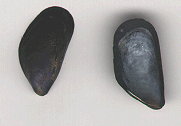 Mytilus edulis - Shell elongated -triangular, rather
plump, with
scarcely noticeable beaks at the apex. Length about 3 inches on the
average. Adult shells are deep bluish black with a shiny periostracum
(outer covering); juveniles show various shades of gray, green and brown,
often exhibiting rays of color. Also called the bay mussel, lives
in rock areas in colonies. M. edulis is a filter feeder with very
few natural enemies. Mytilus edulis - Shell elongated -triangular, rather
plump, with
scarcely noticeable beaks at the apex. Length about 3 inches on the
average. Adult shells are deep bluish black with a shiny periostracum
(outer covering); juveniles show various shades of gray, green and brown,
often exhibiting rays of color. Also called the bay mussel, lives
in rock areas in colonies. M. edulis is a filter feeder with very
few natural enemies. |
|
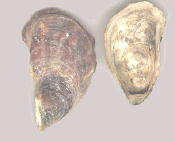 Ostrea lurida - No longer than
3-5 cm long, the shape quite irregular,
depending on the surface of the object on which it grows. Shells
are not especially thick or heavy. Lives in shallow waters with stony
bottoms. This is a common native oyster along the west coast and
is also a filter feeder. Ostrea lurida - No longer than
3-5 cm long, the shape quite irregular,
depending on the surface of the object on which it grows. Shells
are not especially thick or heavy. Lives in shallow waters with stony
bottoms. This is a common native oyster along the west coast and
is also a filter feeder.
|
GASTROPODS
|
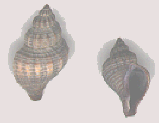 Ocenebra interfossa
- A spindle-shaped shell about 3/4 of an inch
high. There are 5 whorls, high spiral, and a sharp apex. Lives
in the shoreline or on rocks. Commonly called the sculptured rock
shell, because of the large wavy ridges that revolve with the whorls.
This little gastropod is top of the food chain in the mud, eating many
of the bivalves and other gastropods. Ocenebra interfossa
- A spindle-shaped shell about 3/4 of an inch
high. There are 5 whorls, high spiral, and a sharp apex. Lives
in the shoreline or on rocks. Commonly called the sculptured rock
shell, because of the large wavy ridges that revolve with the whorls.
This little gastropod is top of the food chain in the mud, eating many
of the bivalves and other gastropods.
|
|
 Nassarius obsoletus
- Black Dog Whelk; medium sized, surface
blackish with obscure spiral and longitudinal lines, introduced and extremely
abundant in the San Francisco Bay (mud snail), nearly one inch high, with
about 6 whorls. Apex rather blunt, and commonly more or less eroded.
The only sculpture consists of weak revolving lines, plus a few vertical
folds on the early whorls. Inner lip deeply arched. Color deep
purplish black. This is an east coast snail, probably introduced
into California water with young oysters. It is a scavenger that
eats dead fish or other organic debris. Nassarius obsoletus
- Black Dog Whelk; medium sized, surface
blackish with obscure spiral and longitudinal lines, introduced and extremely
abundant in the San Francisco Bay (mud snail), nearly one inch high, with
about 6 whorls. Apex rather blunt, and commonly more or less eroded.
The only sculpture consists of weak revolving lines, plus a few vertical
folds on the early whorls. Inner lip deeply arched. Color deep
purplish black. This is an east coast snail, probably introduced
into California water with young oysters. It is a scavenger that
eats dead fish or other organic debris.
|
|
 Nassarius tegulus - Commonly called the Mud
Dog Whelk.
Lives in the mudflats, about 3/4 of an inch high, a stocky shell of 5 or
6 whorls with a sharply pointed apex. Sculpture of weak revolving
lines, sometimes faintly banded. Inner lip broadly expanded, outer
lip thickened. This group eats similar to N. obsoletus and is hard
to distinguish between the two. Nassarius tegulus - Commonly called the Mud
Dog Whelk.
Lives in the mudflats, about 3/4 of an inch high, a stocky shell of 5 or
6 whorls with a sharply pointed apex. Sculpture of weak revolving
lines, sometimes faintly banded. Inner lip broadly expanded, outer
lip thickened. This group eats similar to N. obsoletus and is hard
to distinguish between the two.
|
|
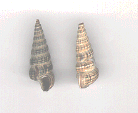 Turritella sp. - Greatly elongated, many whorled shells.
A large group of organisms that live mainly in tropical waters. A
few will venture into he San Francisco Bay, but this group is very rare.
This groups eats food similar to that eaten by N. obsoletus.
Turritella sp. - Greatly elongated, many whorled shells.
A large group of organisms that live mainly in tropical waters. A
few will venture into he San Francisco Bay, but this group is very rare.
This groups eats food similar to that eaten by N. obsoletus.
|
|
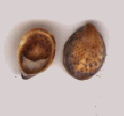 Acmaea
sp - Limpet is the common name for this group. Shells
conical, oval, and open at base, with no opening at the top. No spiral
at any stage of growth and does not have the pearly look to its inside
shell. These gastropods live on stones and grasses at the shoreline,
generally between the tide limits. They are herbaceous which means
they eat small algae or bacteria. Acmaea
sp - Limpet is the common name for this group. Shells
conical, oval, and open at base, with no opening at the top. No spiral
at any stage of growth and does not have the pearly look to its inside
shell. These gastropods live on stones and grasses at the shoreline,
generally between the tide limits. They are herbaceous which means
they eat small algae or bacteria.
|
|